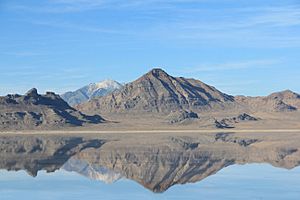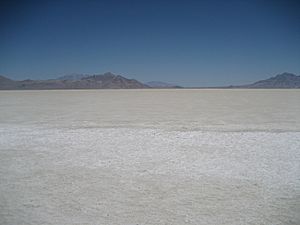Salt lake facts for kids
A salt lake is a special kind of lake. It has a lot of table salt and other minerals dissolved in its water. Imagine a lake that's even saltier than the ocean! Some salt lakes are like that. We usually call a lake a salt lake if it has three grams or more of salt in every litre of water.
Contents
Different Kinds of Salt Lakes
Sometimes, salt lakes have more salt than the sea. These are called hypersaline lakes. If a salt lake has a lot of a mineral called carbonate, it's known as a soda lake. These lakes can be very alkaline, which means they are the opposite of acidic.
We can group salt lakes by how much salt they have:
- Subsaline: A little bit salty (0.5 to 3 parts per thousand).
- Hyposaline: Moderately salty (3 to 20 parts per thousand).
- Mesosaline: Quite salty (20 to 50 parts per thousand).
- Hypersaline: Very, very salty (more than 50 parts per thousand).
How Do Salt Lakes Form?
Salt lakes form when water flows into a lake but has no way to flow out. This means the lake is a "dead end," also called an endorheic basin. The water brings salt and minerals with it.
Since the water can't leave, it slowly evaporates into the air. When the water evaporates, it leaves all the dissolved salts and minerals behind. This makes the lake water saltier and saltier over time.
Salt lakes are great places to collect salt. The high amount of salt also means that only special plants and animals can live in or near these lakes. Sometimes, there's so much salt that very little life can survive there.
When Salt Lakes Disappear
If a salt lake doesn't get enough new water, and more water evaporates than flows in, the lake will eventually dry up completely. When this happens, it leaves behind a flat, dry area covered in salt. This dry lakebed is often called a 'playa', a 'salt flat', or a 'salt pan'.
Related pages
Images for kids
See also
 In Spanish: Lago salado para niños
In Spanish: Lago salado para niños








